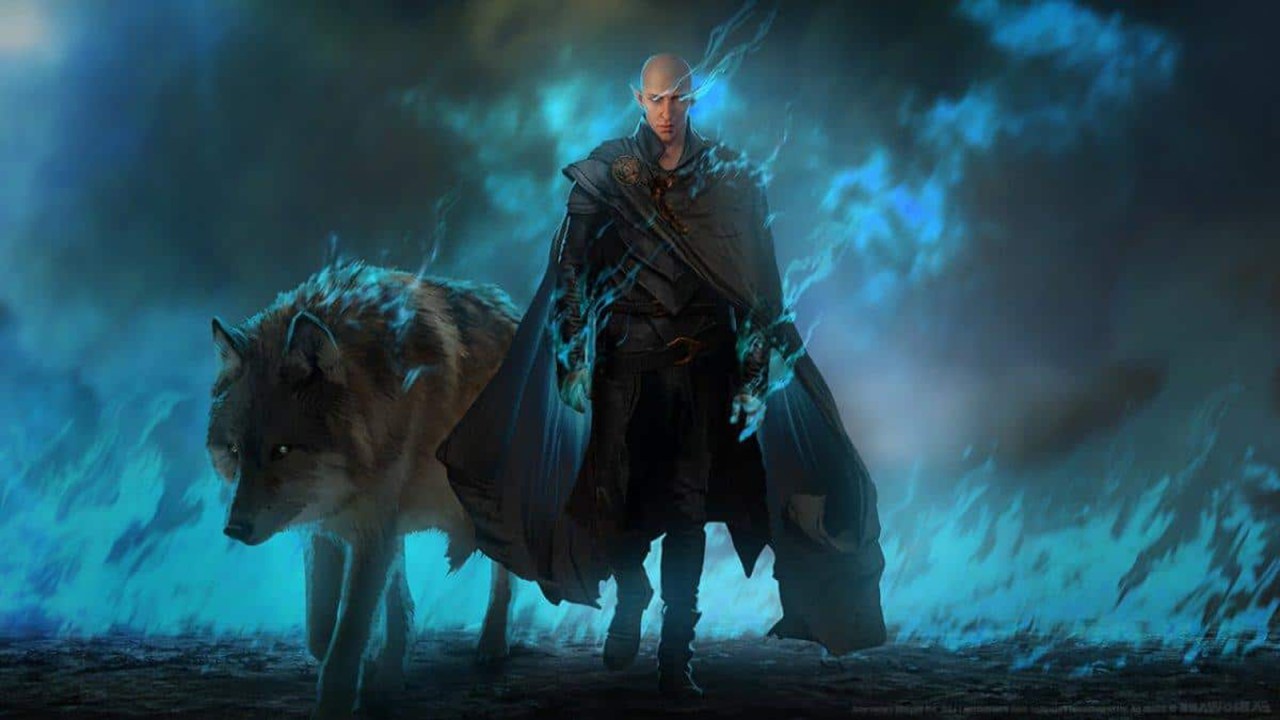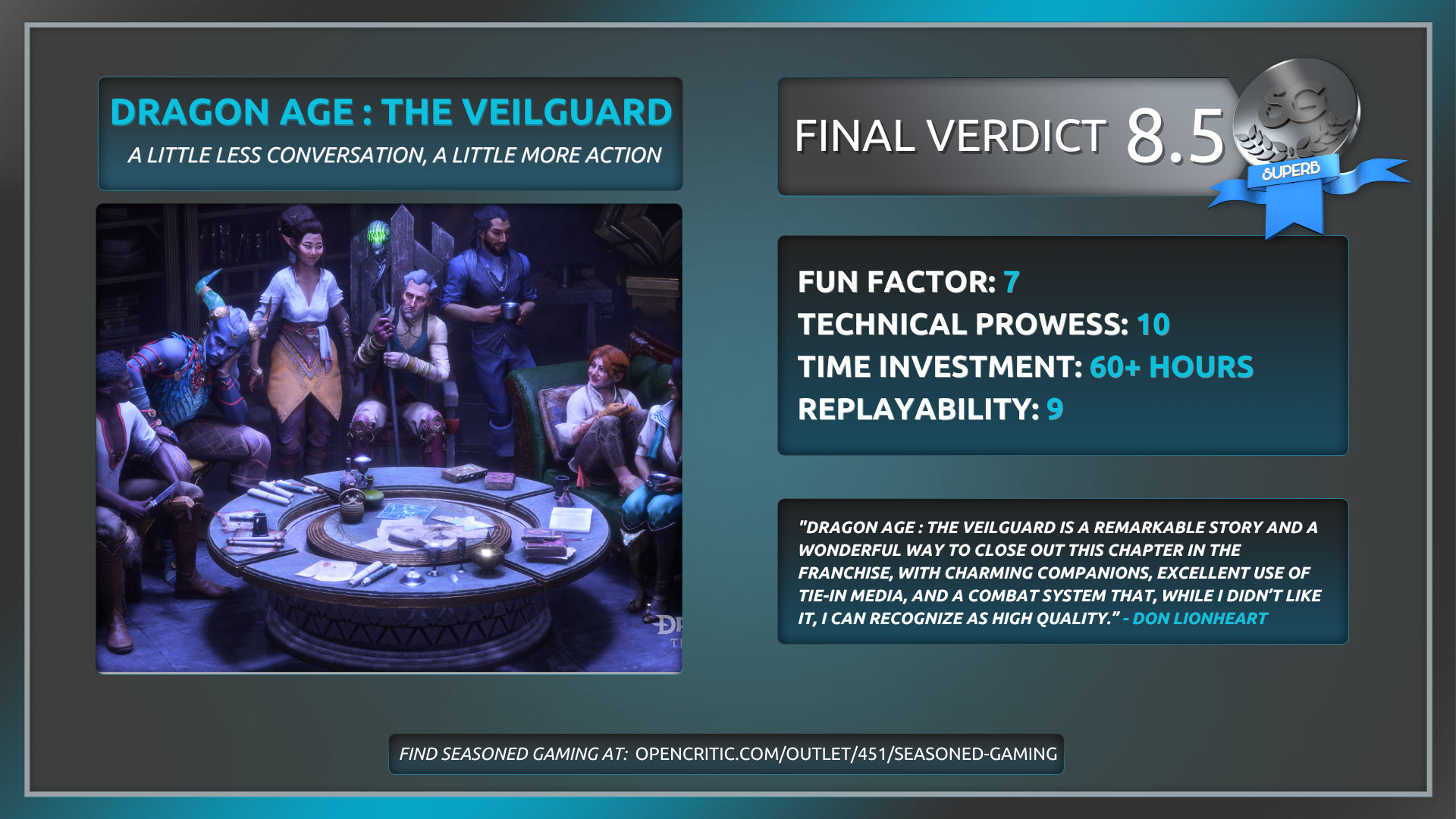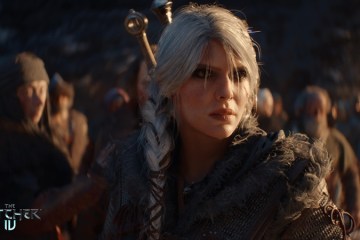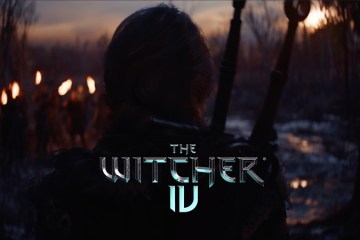Dragon Age: Origins is my favorite game of all time, and the Dragon Age franchise is my favorite franchise of all time. I have spent the last decade cringing, squirming, and, sometimes, screaming at a screen when people online claimed that Dragon Age: Inquisition only won the Game of the Year because 2014 was “a weak year for video games” when I know that it’s actually a phenomenal game well worthy of the acclaim and award. Even Dragon Age 2, the black sheep of the Dragon Age franchise, is pretty great despite its extremely obvious flaws and its insanely short development time. Heck, I am writing this review for Seasoned Gaming because the thoughts that I had on the Dragon Age: The Veilguard reveal trailer riled me up so much, I had to write about it, and that led me down a path as a game commenter/reviewer. I say this at the start because it’s important for the reader to understand the biases I come with in writing this review, and to know why I have been struggling internally on what I think and whether I even wanted to review this game since finishing it. You can see where I ended up.
Dragon Age: The Veilguard, developed by BioWare and published by Electronic Arts, is not the Dragon Age game that I wanted, nor is it the game that the fanbase deserved. I need to be clear: I enjoyed The Veilguard quite a lot. I put 78 hours into it on my PS5/PS5 Pro, I got the platinum trophy in one run, and there’s nothing I would truly call “bad” about the game while there’s a lot that I loved. But for a very large portion of that time, I didn’t feel like I was playing Dragon Age. And that sentence is key, because playing the game is why I have such conflict. Let me explain.
Dragon Age: The Veilguard is an action game with light RPG elements…and therein lies the problem. Origins is a tactical cRPG, 2 is an action-RPG, and Inquisition is a tactical action-RPG. The entire time I was playing The Veilguard, I never felt like I was playing a true RPG. The combat is fast-paced, dodge-and-block-focused, and it works. It actually works pretty well; BioWare managed to make a combat system that I could see people playing on harder difficulties (I played on “Adventurer,” the equivalent of normal), needing to be more strategic with their approach and taking more advantage of the mechanics. Their competency here isn’t really surprising as these are the people behind Mass Effect, a third-person action-RPG shooter, and Anthem, a third-person shooter with some loadout choices. The problem is that those games exist while Dragon Age also exists, and it was not those games (as much as I love Mass Effect and mostly enjoyed Anthem) that Dragon Age has ever been nor should it have become.
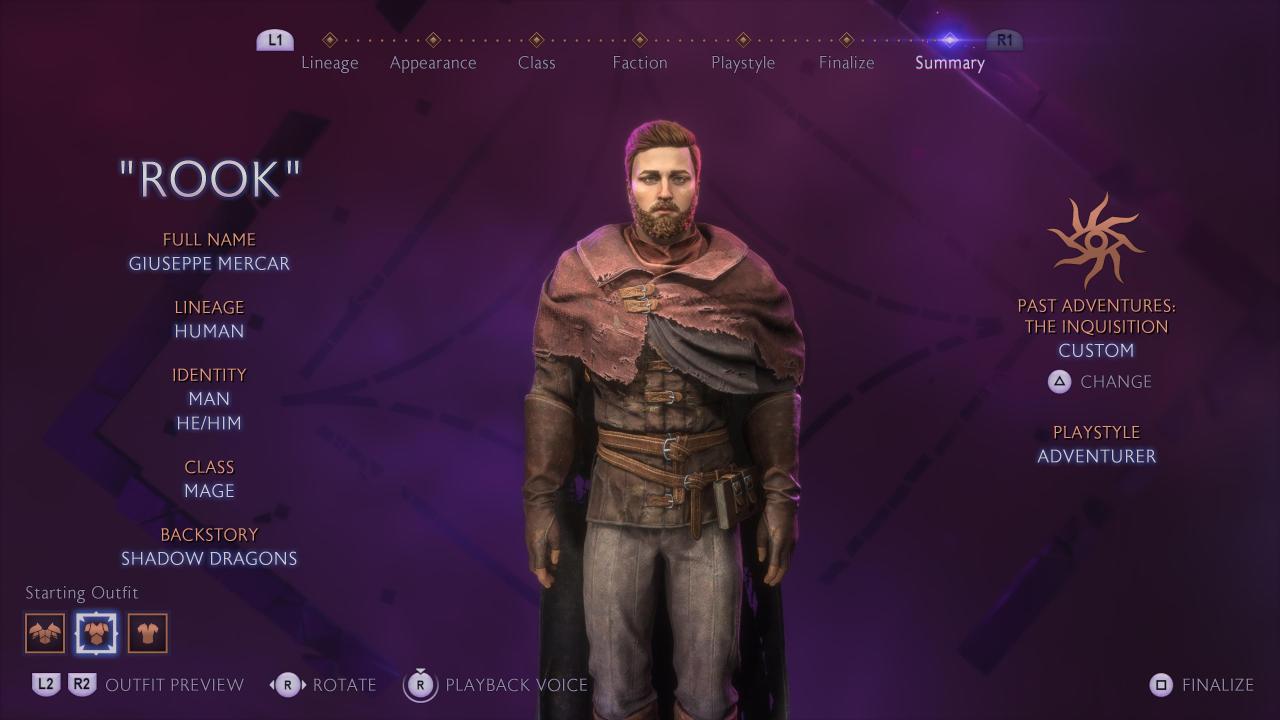
Let’s talk about the setup of combat. You play as Rook, a customizable player character, with one of the most intricate and thorough character creators in any game, to the point where you can make your character look scarily close to yourself. Rook can have one of six backgrounds, with minor implications in dialogue and how characters react to you, and can be one of three classes: mage, warrior, or rogue. Each class has three specializations that you can choose from to focus your gameplay on a specific style. I played as a Mage Spellblade, focusing a lot on using my dagger and orb, which I chose because I enjoyed the speedier casting over the slow staff, a tradeoff for a much shorter range.
Unlike previous entries in the franchise, you only bring 2 companions with you instead of 3. That’s a mistake. You also cannot control your companions directly, instead relying on a combat wheel or quick commands to tell them to use an ability or attack specific targets. That’s another mistake. Each companion’s abilities share a cooldown with the rest of their abilities, but some are longer than others (e.g., if you use a healing ability, you can’t use any other ability until the healing ability’s cooldown is done, but each ability has a different cooldown length), so most of the time, you’re just playing as Rook, who himself/herself is limited by a resource (mana, rage, or momentum, respectively) and restricted to 3 abilities and an ultimate. A pile of mistakes.

All of those mistakes put together means that, most of the time, I was just shooting my orb or staff’s magic blasts at enemies, waiting for the cool abilities to be available. The end result of the combat system means that I was casting occasional spells (hardly any of which come from the lore or the previous entries in the franchise, it should be noted), running around dodging, and blocking when I felt like it. It’s chaotic, it’s a little bit frantic, and it’s even (usually) fun. But it’s not Dragon Age.
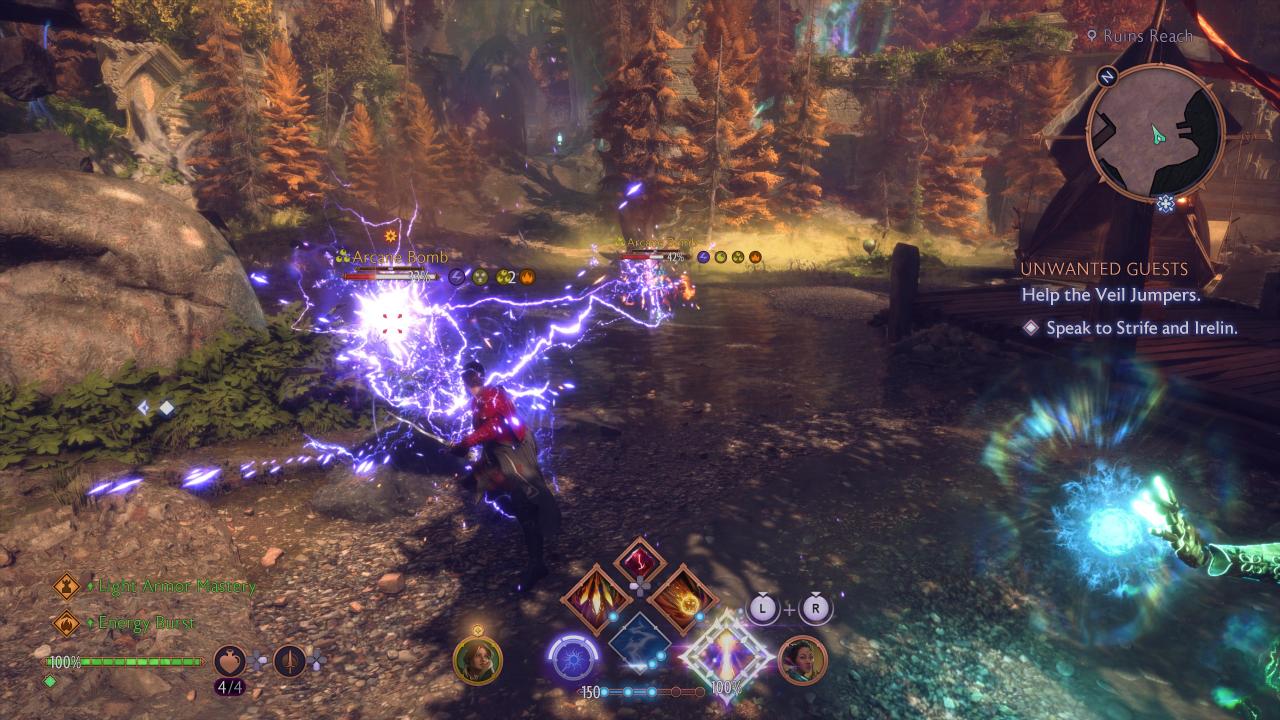
Rook has a variety of skills and abilities that he or she can learn from the skill tree, but with only three ability slots and the abilities spaced so far out in the skill tree, you’re better off picking a few you like and just buffing them with additional skills and selecting appropriate gear rather than experimenting. Plus, there’s no loadout saving in the skill tree or the armors, so it’s just a big pain to try to respect one skill point at a time. The way Rook’s gear is handled is pretty cool, with each piece having something it buffs and, for weapons on a mage, specific types of elemental damage. You can enhance these pieces at the workshop or upgrade their rarity by finding or buying duplicates.
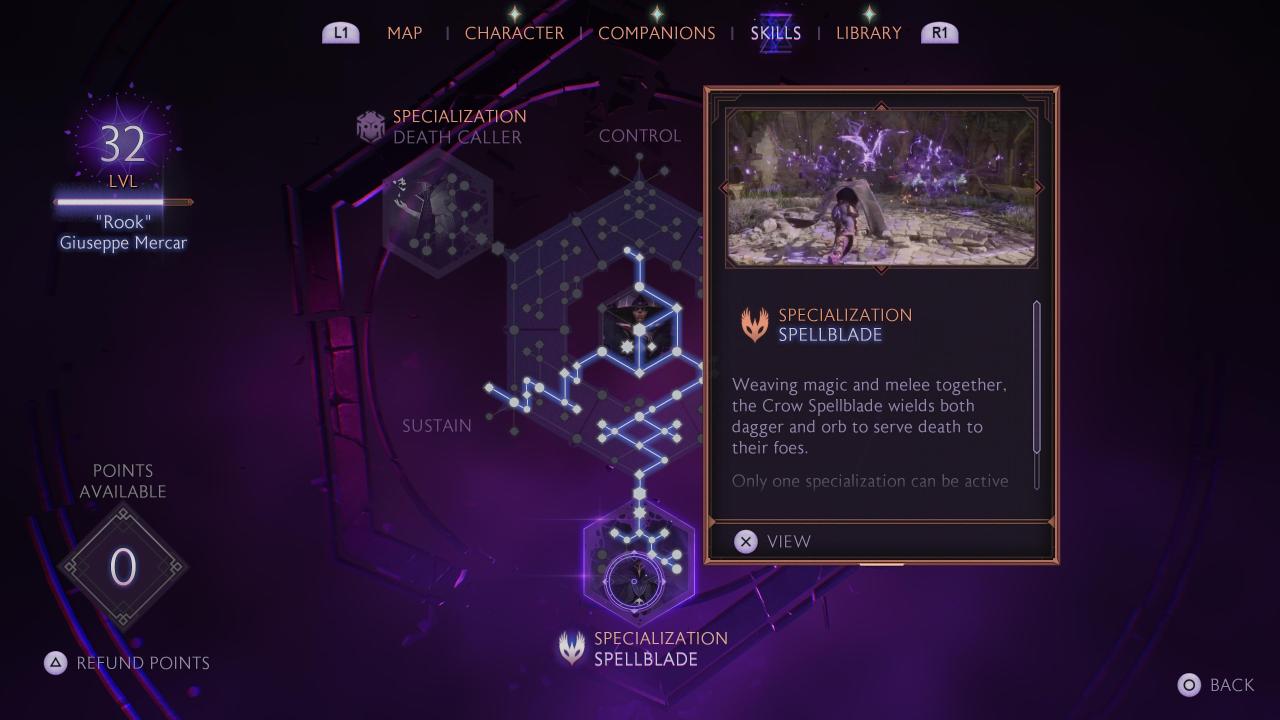
The gear system, especially for Rook, is the most RPG-like aspect of the combat, though it’s drastically tuned down from the full customizability of crafting gear in Inquisition, being much more reminiscent of 2. Companions’ gear works similarly to Rook, except there are only about 4 slots as opposed to Rook’s 9 or so (slot number depends on the class and companion). The style of the clothing of each character will also change based on their gear, but there’s a wardrobe with select “appearances” available in your base to change their look to anything you’ve unlocked, either via finding them or buying them from merchants (there are no micro-transactions in The Veilguard).
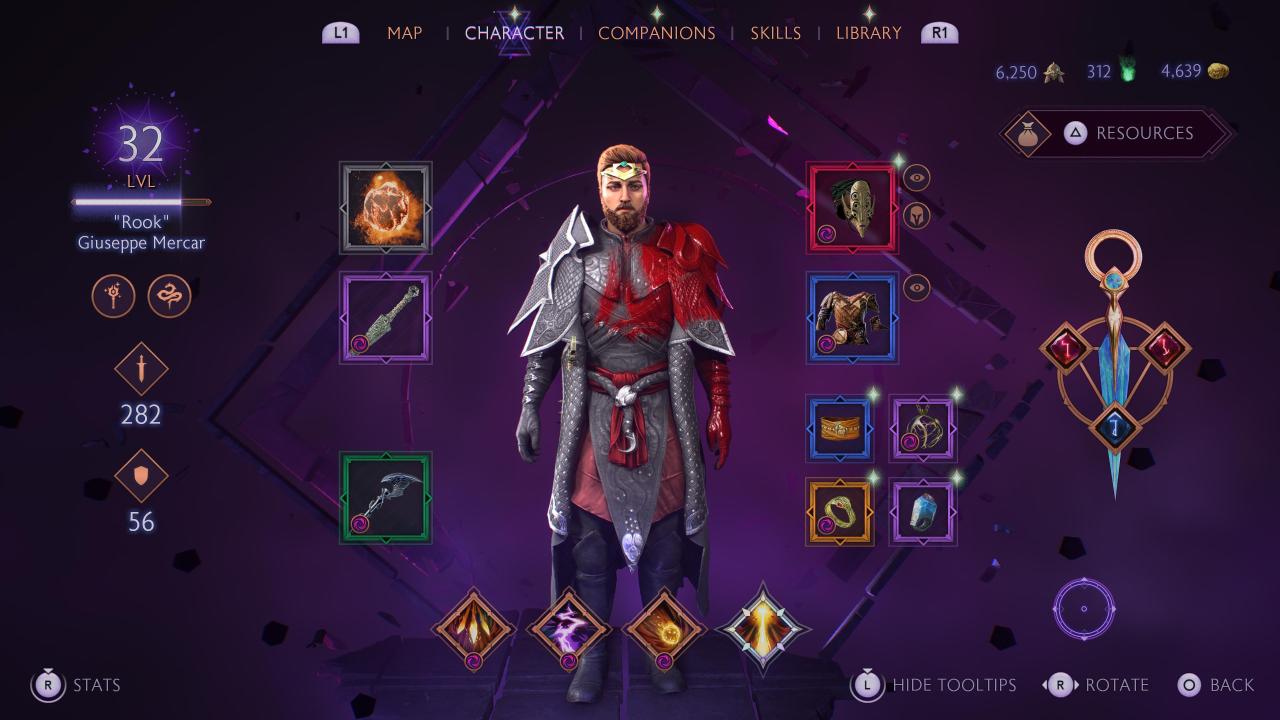
In fact, Dragon Age 2 is an extremely good analog for The Veilguard in a lot of ways. The gear system was very limited in 2, particularly for companions, and the franchise shifted into the action territory for the first time, but it left the emphasis on skills, abilities, and companion control from Origins, which The Veilguard has left behind. 2 is also infamous for its reuse of assets and locations, as well as its linear hallways, and The Veilguard has a very similar feel to it. You will often find yourself running through the same set of alleyways or forest paths, unless you use the generous fast travel system, to get to your destinations, even while on multiple quests. Veilguard outshines 2 in this respect because of the sheer number of different locations in the game, not just in name, but containing totally different aesthetics and scenery. But I did notice that more than one quest would end at the end of a path, exactly where a previous quest ended a few hours earlier.
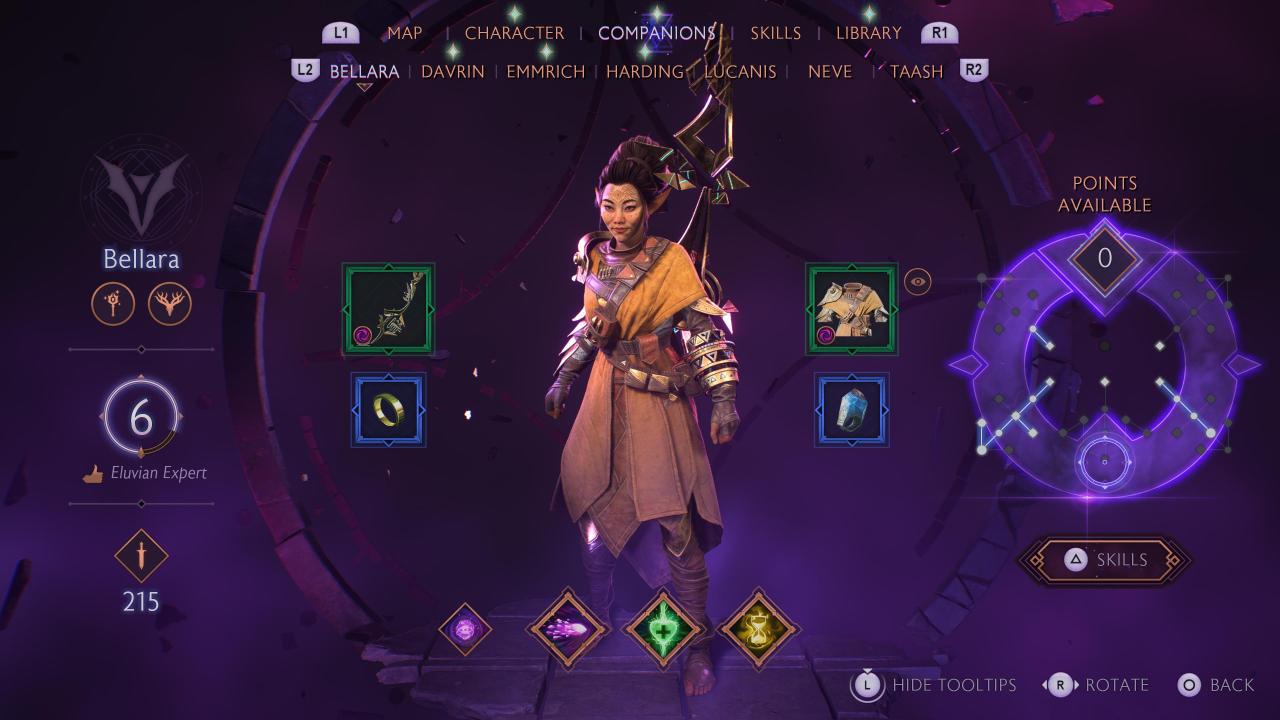
That said, I don’t find that problematic; the design of the game is beautiful, and running through the paths and exploring the branches to find treasures was enjoyable. Seeing cities I’d heard about in the lore and locations I had only dreamt of visiting was incredible, even if I always wanted more: more parts of Nevarra besides the Grand Necropolis, more parts of Minrathous besides Dock Town, more parts of Rivain besides the beach, all beautiful but always wanting more because of how beautiful and well-designed they were and how much I love this world. When not in combat, those are the moments when, and the places where, I felt like I was in Dragon Age.
Let’s talk more about the companions in The Veilguard because, before its release, BioWare stated outright that it felt these were the best companions they’d ever written. Maybe they are, I don’t know, because I hardly got to talk to them. There are seven companions, and six of them are new characters to the games (but some from the extended media) while Scout Lace Harding, a minor character in Inquisition, makes her grand return as a full-fledged companion. Each companion has a companion quest that you need to complete to help them focus fully on the mission, and most of those quests are pretty interesting, with the exceptions, for me, being Taash and Neve.
During these quests, you learn a little bit about each character, and you help them solve their respective problems, be it revenge for having imprisoned your companion or rescuing adorable hostages. But outside of scripted cutscenes in your base, which I’m not sure is properly balanced in terms of who gets how many, and the occasional chat during the companion quests, you don’t get to talk to them. I want to ask Neve why she became a detective in Dock Town, ask Bellara to tell me about her brother Cyrian, ask Davrin what sorts of monsters he’s slain, and ask Taash about dragons! The last game with such limited companion interaction in Dragon Age? 2. These companions may be the best BioWare’s ever written, but I just wish I’d had a chance to find that out instead of being told it.
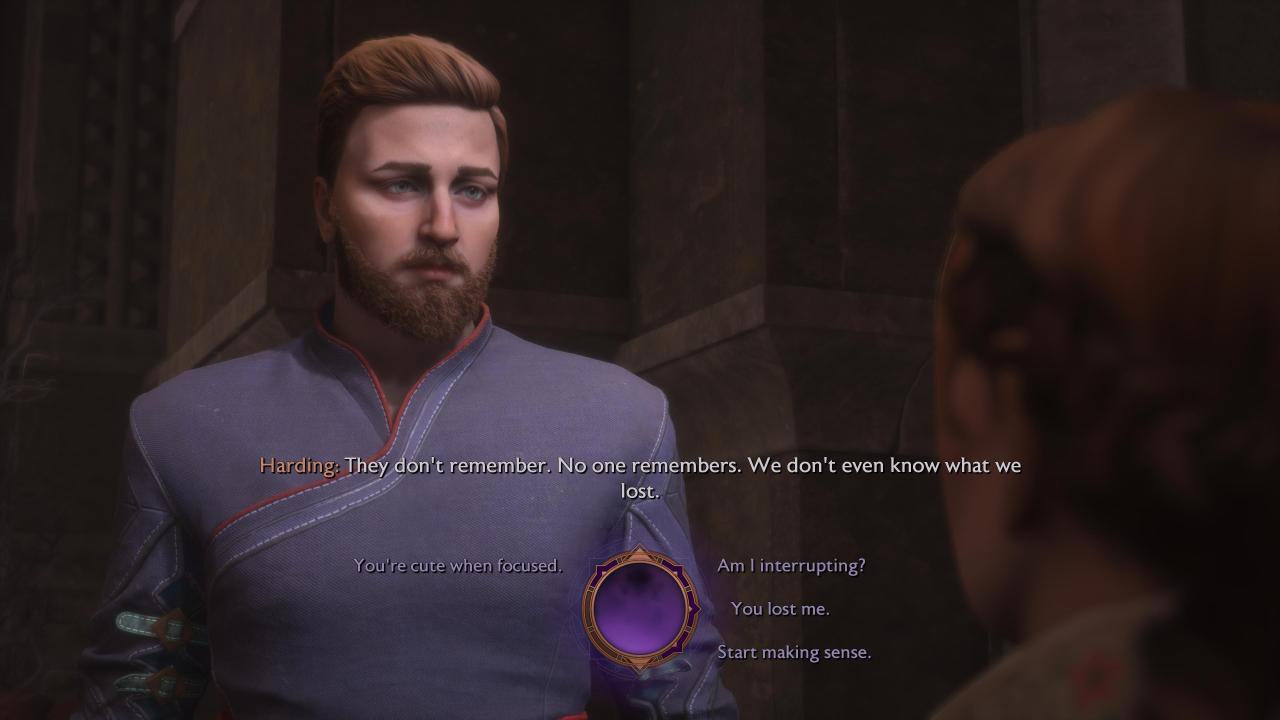
And let’s be clear, this game is well written, about 95% of the time. It’s not groundbreaking writing, and I do wish some of the flavor of the writing in the Codex had made it into the voiced dialogue a bit more, but the characters themselves are endearing. That’s why I wanted to know more! It’s not perfect; I do believe there are scenes about Taash being non-binary that are awkward (albeit not as bad as the internet would have you believe), and the use of “non-binary” as a phrase is peculiar given the setting (and the concept of trans characters has already existed, as have homosexual characters, they’re both just handled much more cleanly in Inquisition, both in terms of the story being told around them and the language used). However, I was tens of hours into this game before I saw any of that, and if someone is going to let slivers of writing ruin an entire game for them, that’s a personal decision.
The story of the game itself is wonderful. I said at the beginning of this review that my biggest issues with the game were in the playing of it, and that’s true because when I’m sitting there watching cut-scenes and story moments, even those of the companion quests, I’m engrossed. I have a huge personal investment in the story, having read the novels, comics, listened to the audio podcast pre-release, and just a general massive understanding of this world, and I felt it was so satisfying, with minor exceptions that I can’t spoil here.
I have two primary critiques of the story. First, until the final act, the companions felt…tangential. It never mattered what companions you brought on a quest because the cut-scenes were always the same. Bringing Davrin the Grey Warden on a quest where the First Warden, Davrin’s boss, orders everyone back to Weisshaupt but doesn’t acknowledge Davrin’s presence was heartbreaking (and not even a problem that 2 had, to break that trend). And it’s like that everywhere, with everyone, and it really hearkens back to my point about this being an RPG last. Second, the lack of integration of prior choices in the earlier entries of the franchise was crushing. BioWare said before release that part of the reason to move to Northern Thedas was to escape from some of the choices and not worry about them, but as the dedicated fan that I am, I desperately missed the easter eggs, the Codex entries, the small cameos that reminded me, “Hey, this is your world, and your choices brought us here.” The lack of that doesn’t take away from the quality of the story, but it’s just a bit of a bummer to the fanbase. All that said, as heartbreaking as that complete and total lack of companion interaction was through 80% of the game, and as crushing the lack of nods to almost any of your past choices was, I was just thrilled to be seeing this world and these locations, and experiencing this story.
As much as I loved the story, I believe that this story should have been the story of Dragon Age 5. I wanted the game that we were promised at the end of Inquisition’s DLC, Trespasser. I wanted to go on the hunt for Solas, to find the Dread Wolf and stop his ritual to tear down the Veil. I understand that time is a cruel mistress and that development struggles happen, so I take in stride that we won’t ever see that story. But we did get this one, and I am so extremely grateful that we did because it turned out to be a great story with a very satisfying conclusion. I do feel that that conclusion was a little rushed, and there are some minor pacing problems in that there’s a large swath of time where you have nothing but side quests and companion quests to do because advancing the main story will bring you past the point of no return. Thankfully, I enjoyed all of that side content, and it was never a bother or problem to play it. I was always happy when new side quests would appear on the world map because it meant I got to go back and explore these beautiful locations and hear more party banter (which was charming and fun but added to my longing to get to talk to the companions personally instead of being a bystander).
Dragon Age: The Veilguard is a really great game. It’s a remarkable story with a wonderful way to close out this chapter in the franchise, with charming companions, excellent use of the tie-in media over the decade since Inquisition with some important characters originating from them, and a combat system that, while I did not and do not like it, I can recognize as high quality and appealing to others. As we say, “You review the game in front of you, not the game you wanted,” and Dragon Age: The Veilguard is a superb game. Maybe it’s not the game that I wanted, but it is one that the world will love.
You can find Seasoned Gaming’s review policy here

